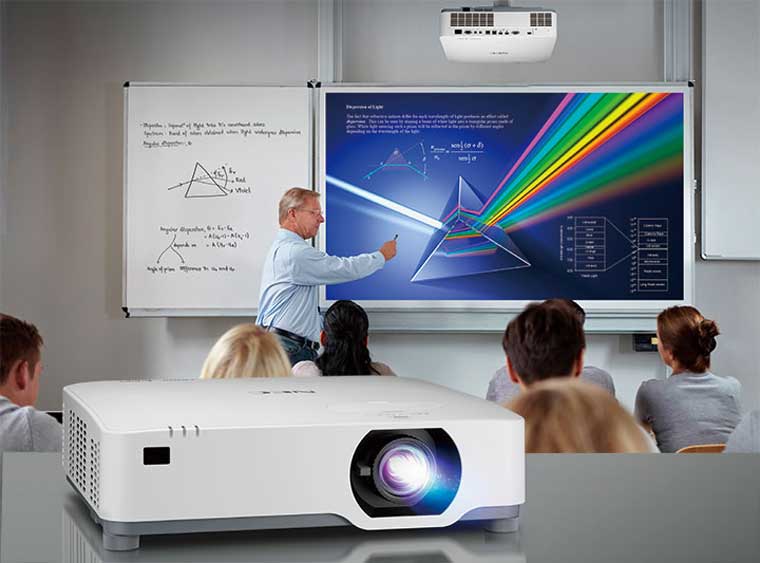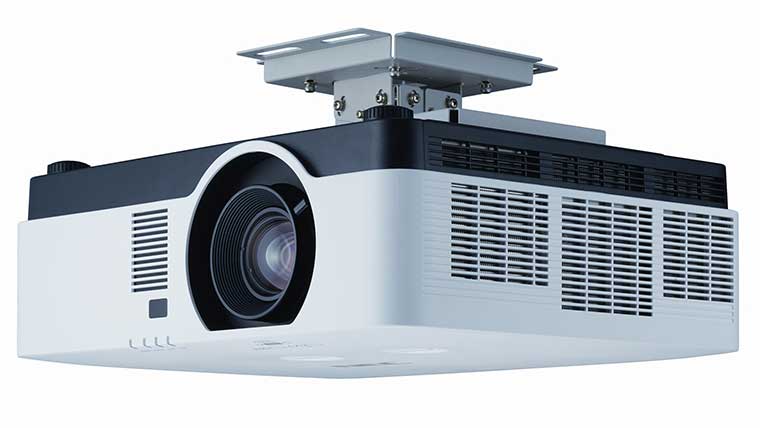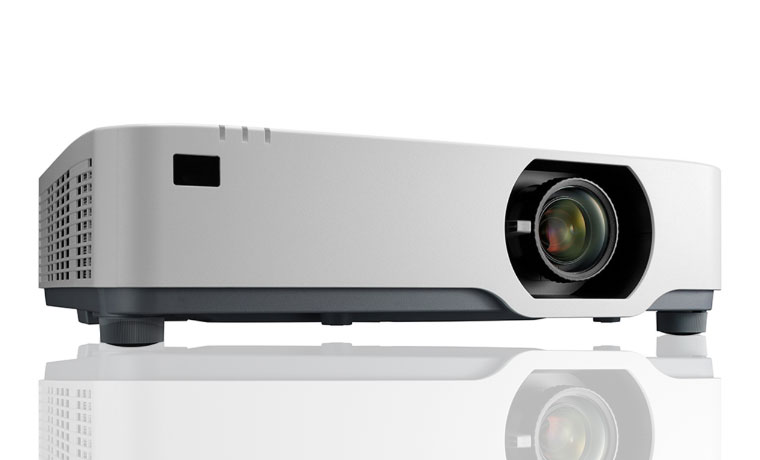Image Quality

It doesn't matter how good the picture looks out-of-the-box, if it doesn't stay looking that good for a month or a year from installation. With the advent of laser-based projection, longevity is becoming a problem for the history books. It is universally accepted that image quality of a laser-based projector will degrade less over time. Older bulb-based projectors may maintain their brightness for about a year, while on the other hand, more modern laser-based Sharp NEC projectors maintain their brightness consistently for 20,000 hours which equates to several years.
However, just because a projector has a rated brightness of 5,000 or 10,000 lumens does not mean that all the light output is useable in the real world. There’s an ancient battle in the realm of commercial projection, and that is the battle between image quality, brightness, and color accuracy. To improve color accuracy of many projectors, one must reduce brightness. In fact when delivering good image quality, many projectors only deliver about half of their rated brightness but reducing brightness may negatively impact the viewing experience in a room with ambient light. And thus, the battle lands us in a full circle where no one wins.
How much of a projector's brightness can be utilized is simply not the same across all projectors. Many projectors sacrifice picture quality for a higher brightness rating. So that 5000-lumen projector you installed in a boardroom may only deliver half of that by the time you make your client's corporate colors look right. Why should someone have to buy a 10,000-lumen projector to get an accurate 5000-lumen image?
Companies like Sharp NEC are getting better at optimizing colors delivered by their projector's high brightness laser light sources. For projectors like the NEC P506QL, which we just reviewed, they can now deliver a usable picture even in its brightest picture modes, for hours and hours. To learn more about the NEC P506QL projector check out the review here.
Let’s look at this from the perspective of a graphic design school. Color is incredibly important when it comes to this field of work, and as far as uniformity and color accuracy, consistency over time is absolutely key. So, installing a projector without confidence it will deliver its rated brightness while maintaining color accuracy over time is a concern you should take seriously.
Not only do you get a great-looking image for a long time, like a flat panel, a projection system allows you to deliver a much larger picture, which certainly can be useful for collaboration and make it easier to view from the back of a large conference or classroom.
Noise
For some, the steady hum of a projector is a calming sound. For the rest of us, dare I say, “normal” people, this noise can be a serious nuisance and make it impossible to focus, present, or listen in certain situations to what’s going on. Just imagine being a museum tour guide and having to yell over the projector in a crowded room, it’s not a good look (or sound).
For older projection technology that used bulbs, the projectors were optimized to keep the unit as cool as possible, which could become difficult given how bright (and hot) some of these bulbs were. And to keep things cool, you need to run air through the projector, and those motors? Yeah, they make noise.
We don’t often talk about how noisy projectors are because our main focus is always image quality. However, according to Sharp NEC, this is a problem they’re hearing more and more of from the field. Even when discussing new laser-based projectors, there is still complaints from installers and others that the units are just too loud to be suitable for their installations.
This is where Sharp NEC’s P525UL projector’s quiet operation really comes into full effect. For the entry installation project, it offers incredibly quiet operation noise, which can help reduce the headaches involved in environments that require low noise floors.

Connectivity
In our modern world, how we actually get images to the projectors has become a topic of huge interest from the community. It used to be a fairly simple process, wherein a source was connected to a set of jacks on a projector and voila, you had an image.
But now, the variety of connectivity is abundant, and the issue of AV over IP is a topic gaining a lot of interest. You need to consider several questions such as what are you trying to connect? Are there Apple and Windows users? Are you trying to connect and display multiple PCs on screen simultaneously? There is much talk about what the future of connectivity will hold, but perhaps the most important thing to remember is that you need to optimize a projector for your specific build requirements and needs.

While wireless products are generally in vogue, there are environments where a wireless projector may not be inviting. For example, a classroom where smart kids can navigate their way on to a projector screen with ease. But even without the threat of smart and sneaky kids, running a projector via LAN line can actually make maintenance easier on the IT staff, who can remote into a malfunctioning projector and save themselves a jaunt across campus.
However, maximum flexibility is always a topic of concern for projector manufacturers. That’s why companies like Sharp NEC have produced classroom standard series projectors, which offers wireless capability and a technology called MultiPresenter, which enables it so everyone can connect using multiple connections and be controlled very precisely. While this technology does require a software install and a bit of set up on the front end to get it running, it is perfect for an environment where multiple presenting technologies will be used and make it compatible with everything.
Control
Last, but certainly not least in our list of seven possible projector pain points is control. Even the simple act of turning on a projector is an important piece of information for installers to consider. If we look back at lamp-based projectors, depending on how the manufacturer built them, they may turn on instantly, or they may have a ramp-up time before you actually start seeing an image, this actually created a lot of problems in the industry.
For example, a professor might hit the button on the podium to turn on the projector and nothing happens immediately. So what might they do? They hit the button again, and again, and again. Then, IT is called in and the issue is resolved, but now we’ve wasted 30 minutes and angered a professor, annoyed an IT guy, and probably lost the interest of the students as well. This is where ease-of-use and control really comes into play for a projector installer. With laser-based or LED projectors, the ramp-up time to brightness becomes a non-issue and within a few seconds there’s an image on the screen, so you don’t have that initial “is it on?” panic.
The ability for a member of the IT team to log into a networked projector also eliminates the need to walk all the way across campus or go up several flights of stairs to a boardroom to troubleshoot an issue. The end result of a projector that’s easier to control and use will typically be that it is utilized more, resulting in fewer people being mad at each other about getting a piece of technology functioning.
In Conclusion
The promise of laser and LED technology proves to be hugely consequential for people looking to install higher-end projector systems across a variety of verticals. With advancements in brightness, noise reduction, and ease of installation, it is now simpler than ever to lean on projectors for commercial projects. With less maintenance required, exceptional image quality, more flexibility, better longevity than ever before, and last but not least, a much larger image, it’s clear projectors are still the best path forward for most installations.





